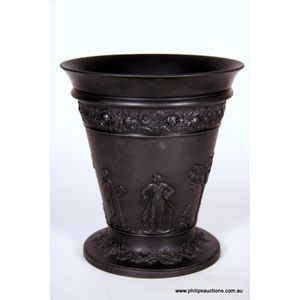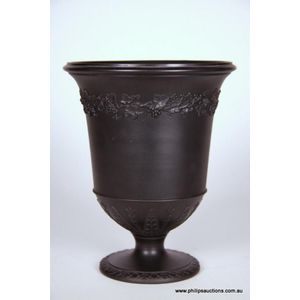Wedgwood Basalt Ware Urn with Grape Vine Border
You must be a subscriber, and be logged in to view price and dealer details.
Subscribe Now to view actual auction price for this item
When you subscribe, you have the option of setting the currency in which to display prices to $Au, $US, $NZ or Stg.
- Dating English Ceramics - Excellent detailed reference books such as Godden's Encyclopaedia of British Pottery and Porcelain Marks will help to identify and date specific manufacturer's marks.
However, there are a few simple guidelines which may also help.
The inclusion of the word 'England' on an item ensured compliance with the American McKinley Tariff Act 1891, which was important for British exporters. An item so marked would have been made after 1891.
In 1921 the act was revised to require the phrase 'Made in' followed by the country. So if an item is marked 'Made in England', it is generally considered to be made after that date, although some manufacturers were using this phrase pior to the act being changed.
The use of the word 'Ltd' of 'Limited' after a company's name indicates a date after 1860, though with ceramic manufacturers this did not become general practice until the 1880's. - Acanthus - A stylized leaf motif, one of the primary decorative elements of classical Greek and Roman architecture, derived from the genus of flowering plants in the family Acanthaceae, native to tropical and subtropical regions of the Mediterranean area. It is a common element in classical Greek and Roman design, and is often seen in Corinthian and Composite order columns and used as a decorative element in English, European and Australian furniture, particularly on the curve of a leg, and as decoration for a corbel.
- Basalt - Basalt is a hard, dense volcanic rock formed from the rapid cooling of basaltic lava, and makes up most of the earth's oceanic crust.
However it is also the name given by Josiah Wedgwood in 1768 to a fine black unglazed porcelain which he called Wedgwood Black Basalt.
Using this fine-grained stoneware he was able to produce copies of the newly excavated Etruscan pottery from Italy, with a lustrous and smooth, surface, and this new innovation proved to be a huge commercial success. - Lappet Decoration - In the context of furniture, ceramics, and oriental wares, the word "lappet" refers to a decorative motif that consists of a repeated pattern of stylized or abstracted "lappets."
A lappet in this context is a decorative element that resembles a small, hanging flap of cloth or fabric, but rather are stylized patterns that resemble the shapes and folds of lappets. They can be found on a wide range of objects, including furniture, vases, bowls, and plates.
Lappet decoration can take many different forms, but typically consists of a series of semi-circular or pointed shapes that are repeated in a continuous pattern. The shapes may be simple or highly ornate and may be arranged in a regular or irregular pattern. The design may also include other decorative elements, such as floral or foliate motifs.
Lappet decoration is often associated with Asian design traditions, and can be found on a wide range of objects from these regions, including Chinese porcelain, where lappet decoration is often used as a symbol of abundance and prosperity, and is believed to have protective and auspicious qualities.
This item has been included into following indexes:
-
Wedgwood (England), item types
- black basalt ware 201
- urns 100
Visually similar items

Wedgwood black basalt vase. 22 cm high

A Wedgwood basalt Ware jardiniere, 1930 and after, the conical shaped jardiniere with a spreading foot, slip decorated with a continuous classical scene of goddesses with their symbolic accoutrements and making offerings, between a floral and fruiting band

A Wedgwood basalt Ware jardiniere, circa 1909-1929, of conical shape with a spreading foot, with a slip decorated classical scene of figures representative of the liberal arts in a landscape setting, between a floral and fruiting band to the upper body and

Porcelain bowl, mid 20th century Berlin Studio line blanc de chine diameter 20.5 cm, height 12.5 cm
